The Intel Comet Lake Core i9-10900K, i7-10700K, i5-10600K CPU Review: Skylake We Go Again
by Dr. Ian Cutress on May 20, 2020 9:00 AM EST- Posted in
- CPUs
- Intel
- Skylake
- 14nm
- Z490
- 10th Gen Core
- Comet Lake
Our Office and Science Test section focuses significantly on real-world testing, user experience, with a slight nod to throughput. In this section we cover application loading time, image processing, simple scientific physics, artificial intelligence, and AVX accelerated code.
All of our benchmark results can also be found in our benchmark engine, Bench.
Office Tests
Application Load: GIMP 2.10.4
One of the most important aspects about user experience and workflow is how fast does a system respond. A good test of this is to see how long it takes for an application to load. Most applications these days, when on an SSD, load fairly instantly, however some office tools require asset pre-loading before being available. Most operating systems employ caching as well, so when certain software is loaded repeatedly (web browser, office tools), then can be initialized much quicker.
In our last suite, we tested how long it took to load a large PDF in Adobe Acrobat. Unfortunately this test was a nightmare to program for, and didn’t transfer over to Win10 RS3 easily. In the meantime we discovered an application that can automate this test, and we put it up against GIMP, a popular free open-source online photo editing tool, and the major alternative to Adobe Photoshop. We set it to load a large 50MB design template, and perform the load 10 times with 10 seconds in-between each. Due to caching, the first 3-5 results are often slower than the rest, and time to cache can be inconsistent, we take the average of the last five results to show CPU processing on cached loading.
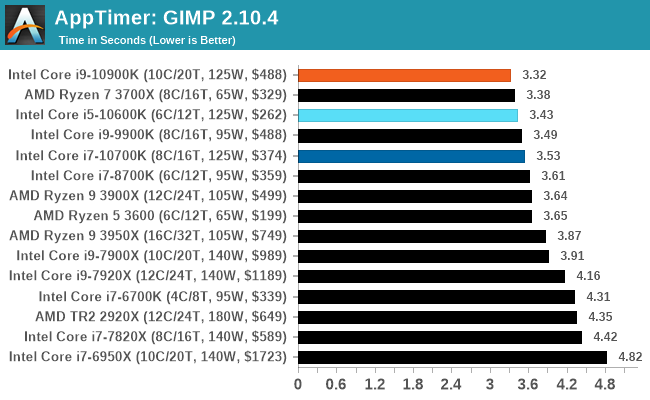
GIMP likes fast single core performance, and so the Core i9 wins here.
Agisoft Photoscan 1.3.3: 2D Image to 3D Model Conversion
One of the ISVs that we have worked with for a number of years is Agisoft, who develop software called PhotoScan that transforms a number of 2D images into a 3D model. This is an important tool in model development and archiving, and relies on a number of single threaded and multi-threaded algorithms to go from one side of the computation to the other.
In our test, we take v1.3.3 of the software with a good sized data set of 84 x 18 megapixel photos and push it through a reasonably fast variant of the algorithms, but is still more stringent than our 2017 test. We report the total time to complete the process.
Agisoft’s Photoscan website can be found here: http://www.agisoft.com/
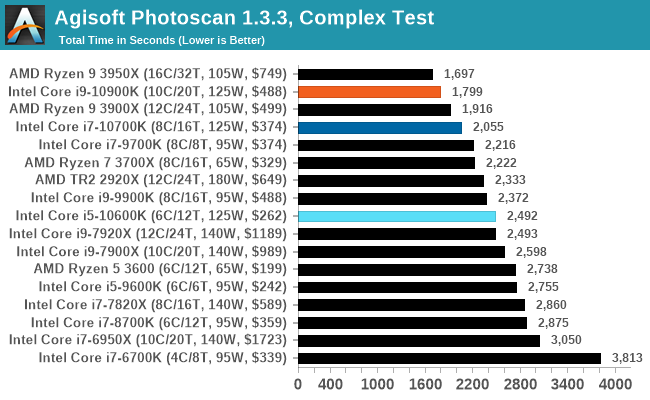
Agisoft is a mix of variable threaded workloads, so a good balanced system works best. Intel's $500 option is faster than AMD's $500 option here, with two fewer cores.
AI Benchmark
One of the longest time requests we’ve had for our benchmark suite is AI-related benchmark, and the folks over at ETH have moved their popular AI Benchmark from mobile over PC. Using Intel’s MKL and Tensorflow 2.1.0, we use version 0.1.2 of the benchmark which tests both training and inference over a variety of different models. You can read the full scope of the benchmark here.
This is one of our new tests in the database, and we are still gaining data for it.
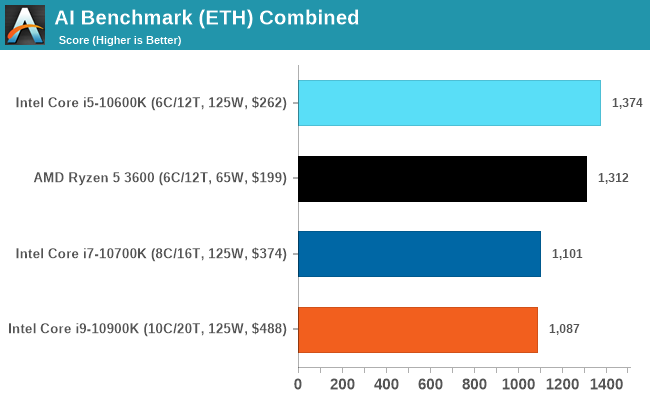
AIBench is a new test here, covering both training and inference. In the breakdown of results, we noticed that the faster processors were actually slower, scoring a lower result. We believe this is down to the lower bandwidth/core afforded by the 10c design against the 6c design.
Accelerated Science Tests
3D Particle Movement v2.1: Brownian Motion
Our 3DPM test is a custom built benchmark designed to simulate six different particle movement algorithms of points in a 3D space. The algorithms were developed as part of my PhD., and while ultimately perform best on a GPU, provide a good idea on how instruction streams are interpreted by different microarchitectures.
A key part of the algorithms is the random number generation – we use relatively fast generation which ends up implementing dependency chains in the code. The upgrade over the naïve first version of this code solved for false sharing in the caches, a major bottleneck. We are also looking at AVX2 and AVX512 versions of this benchmark for future reviews.
For this test, we run a stock particle set over the six algorithms for 20 seconds apiece, with 10 second pauses, and report the total rate of particle movement, in millions of operations (movements) per second. We have a non-AVX version and an AVX version, with the latter implementing AVX512 and AVX2 where possible.
3DPM v2.1 can be downloaded from our server: 3DPMv2.1.rar (13.0 MB)


No real surprises in our 3DPM tests.
y-Cruncher v0.7.6: Microarchitecture Optimized Compute
I’ve known about y-Cruncher for a while, as a tool to help compute various mathematical constants, but it wasn’t until I began talking with its developer, Alex Yee, a researcher from NWU and now software optimization developer, that I realized that he has optimized the software like crazy to get the best performance. Naturally, any simulation that can take 20+ days can benefit from a 1% performance increase! Alex started y-cruncher as a high-school project, but it is now at a state where Alex is keeping it up to date to take advantage of the latest instruction sets before they are even made available in hardware.
For our test we run y-cruncher v0.7.6 through all the different optimized variants of the binary, single threaded and multi-threaded, including the AVX-512 optimized binaries. The test is to calculate 250m digits of Pi, and we use the single threaded and multi-threaded versions of this test.
Users can download y-cruncher from Alex’s website: http://www.numberworld.org/y-cruncher/
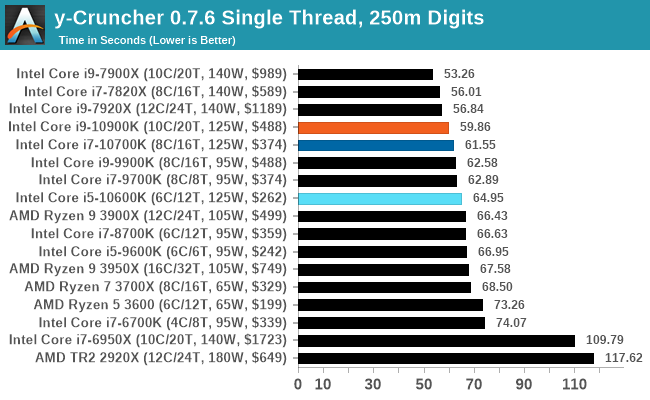
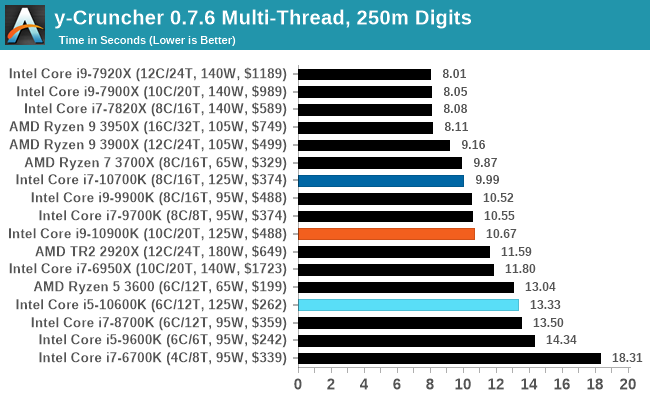
y-Cruncher is another one where the Core i9 performs worse than the Core i7 in the multithreaded test, despite being better on the single threaded test. We again put this down to memory bandwidth. We need to update this test to the latest version of y-Cruncher, which has additional optimizations for Zen 2 processors, but also to increase the digit count in our MT test.











220 Comments
View All Comments
Khenglish - Wednesday, May 20, 2020 - link
Ian, for the Crysis CPU render test you'd probably get higher FPS disabling the GPU in the device manager and set Crysis to use hardware rendering. Disabling the GPU driver enables software rendering by default on Windows 10. The Win10 rendering does stutter worse than the reported FPS though, so take from it what you want.shaolin95 - Wednesday, May 20, 2020 - link
"But will the end-user want that extra percent of performance, for the sake of spending more on cooling and more in power?"Such retarded comment. More power...do you actually know who little difference this makes in a year. Wow this place is going down hill fast.
Oh and a cooler you know we don't have to change our cooler with every CPU purchase so don't make it seem like this HUGE issue...your AMD fanboy colors are showing VERY clearly.
schujj07 - Wednesday, May 20, 2020 - link
If you think you can use the 212 EVO you have from a 6700k or 7700k to keep the 10900k cool you are absolutely nuts. "Speaking with a colleague, he had issues cooling his 10900K test chip with a Corsair H115i, indicating that users should look to spending $150+ on a cooling setup. That’s going to be a critical balancing element here when it comes to recommendations." This isn't any form of fanboyism. This is stating a fact that to squeeze out the last remaining bits of performance in Skylake & 14nm Intel had to sacrifice massive amounts of heat/power to do so.Maxiking - Wednesday, May 20, 2020 - link
If you have issues cooling 10900k with H115i, the problem is always between the monitor and chair.They were able to cool OC 10900k with 240m AIO just lol
Incompetency of some reviewers is just astonishing
schujj07 - Wednesday, May 20, 2020 - link
All depends on the instructions that you are running. From Tomshardware: "We tested with the beefier Noctua NH-D15 and could mostly satisfy cooling requirements in standard desktop PC applications, but you will lose out on performance in workloads that push the boundaries with AVX instructions. As such, you'll need a greater-than-280mm AIO cooler or a custom loop to unlock the best of the 10900K. You'll also need an enthusiast-class motherboard with beefy power circuitry, and also plan on some form of active cooling for the motherboard's power delivery subsystem." https://www.tomshardware.com/reviews/intel-core-i9..."While Intel designed its 250W limit to keep thermals 'manageable' with a wide variety of cooling solutions, most motherboard vendors feed the chip up to ~330W of power at stock settings, leading to hideous power consumption metrics during AVX stress tests. Feeding 330W to a stock processor on a mainstream motherboard is a bit nuts, but it enables higher all-core frequencies for longer durations, provided the motherboard and power supply can feed the chip enough current, and your cooler can extract enough heat.
To find the power limit associated with our chip paired with the Gigabyte Aorus Z490 Master motherboard, we ran a few Prime95 tests with AVX enabled (small FFT). During those tests, we recorded up to 332W of power consumption when paired with either the Corsair H115i 280mm AIO watercooler or a Noctua NH-D15S air cooler. Yes, that's with the processor configured at stock settings. For perspective, our 18-core Core i9-10980XE drew 'only' 256W during an identical Prime95 test." https://www.tomshardware.com/reviews/intel-core-i9...
Think it is still a pebkac error?
alufan - Thursday, May 21, 2020 - link
try this he doesn't slate the intel or amd just a proper review with live power draw at the socket OMG lol you need your won power plant when you run these let alone over clock ithttps://www.kitguru.net/components/leo-waldock/int...
Spunjji - Tuesday, May 26, 2020 - link
"They were able to cool OC 10900k with 240m AIO just lol"Who were? Everyone I've read indicates that with a 240mm AIO, CPU temps hit 90+
Pathetic comment troll is pathetic.
Retycint - Wednesday, May 20, 2020 - link
It is, in fact, a huge issue because most people won't have high end coolers necessary to keep the thermals under control. Personal attacks such as accusing people of being a "fanboy" just degrades your argument (if there was any in the first place) and make you look dumbSpunjji - Tuesday, May 26, 2020 - link
"Such retarded comment."The pure, dripping irony of using a slur to mock someone else's intelligence, but screwing up the grammar of the sentence in which you do it...
Some people build from scratch. Some people have uses for their old system. larger PSUs and suitable cooling to get optimal performance from this CPU don't come cheap. Go home, troll.
watzupken - Wednesday, May 20, 2020 - link
Not surprising, Intel managed to keep their advantage in games by pushing for higher frequency. However the end result is a power hungry chip that requires some high end AIO or custom water cooler to keep cool. I agree that Intel is digging themselves deeper and deeper into a hole that they will not be able to get out so easily. In fact I don't think they can get out of it until their 7nm is ready and mature enough to maintain a high frequency, or they come out with a brand new architecture that allows them to improve on Comet Lake's performance without the crazy clockspeed. Indeed, they will not be able to pull another generation with their Skylake + 14nm combination looking at the power consumption and heat generation issue. Intel should consider bundling that industrial chiller they used to cool their 20 core chip during the demo.